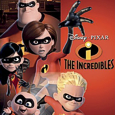Pixar Animation Studios/Walt Disney Pictures (November 5 2004), Walt Disney Home Entertainment (April 12 2011), 2 Blu-ray Discs plus DVD and Digital Copy, 115 mins plus supplements, 1080p high-definition 2.39:1 widescreen, DTS-HD 5.1 Master Audio ES, Rated PG, Retail: $45.99
Storyboard:
Once known as the amazing Mr Incredible, Bob Parr is now an ageing superhero who has, with the rest of his family, been placed “underground” in a government hidden identity program to protect them from a number of ungrateful people the supers have helped save over the years and any ensuring lawsuits. When a long-thought gone villain pops up again to take revenge on the Parrs, Bob dons his Incredible suit once more in a secret bid to save his family. But when Mr Incredible gets trapped in the hidden lair of the bitter Syndrome, it’s up to his wife, Elastigirl, and kids, Violet and Dash, to track him down – after a stop at hero-costume designer Edna Mode – and save the day once more!

The Sweatbox Review:
One by one, Pixar’s soon to be classics have been making the jump to Blu-ray, and just in time before he makes his own leap into the world of live-action blockbuster directing with the fourth in the Mission: Impossible franchise set for release this summer, it’s now the turn of Brad Bird’s debut picture for The Lamp to go hi-def! It’s hard to remember it now this particular film has proven to be such a bona fide blockbuster smash hit, earning platitudes and fame for Bird, as well as multiple awards – including the Academy Award for Best Animated Feature – to boot, but The Incredibles was anything but a sure fire thing when originally released.
Bird, the director of the astonishing The Iron Giant, was coming off the back of that film’s poor box office showing (due, markedly, to Warner Brothers’ dropping the marketing ball) and was pushing Pixar into areas that they had previously kept away from. In addition, the film kept going through title changes, and nearly arrived on screens as The Invincibles before The Incredibles title meant every review wound quoting the name of the film to describe the movie, something that got amusingly clichéd! Batting five for five, the release of The Incredibles, Pixar’s sixth film for Disney before their merger, was seen as perhaps too much of a departure for the company: too dark, too adult and too risky.
As Finding Nemo was perceived the year before and Cars was to be next, Pixar’s cone of silence during production and the eventual pre-release buzz neither suggested if the film would be a great success, or a colossal failure. In the end, Pixar had nothing to worry about: The Incredibles has such an abundance of “cool” factored in that it could never have been anything but a smash hit in theaters, and Bird’s reputation at the Studio and now elsewhere was confirmed. As well as bringing in “outsider” Bird to direct, The Incredibles shifts gears in a number of other ways too: the story is obviously on a grander, fantasy scale (out with the antics of toys in the bedroom and in with huge sets and epic, outdoor action scenes) than we have had from Pixar before, and the tone gets an upgrade (from talky buddies to real emotional depth and serious, life-and-death issues).
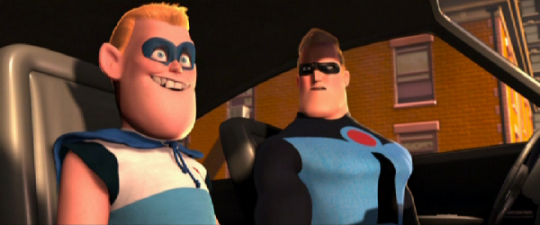
Also gone, following in Nemo’s footsteps, is Randy Newman’s usual jaunty musical style, here not even present on Disney’s CGI animated castle logo, making way for another debuting Pixar fixture, composer Michael Giacchino, who can seemingly do no wrong and whose big ‘n’ brassy 1960s retro-action-jazz score here reminded me of the big band sound from The Jungle Book and hints of Neal Hefti’s Batman music. It’s unlike anything heard in any recent Disney film, keeping the grand sweep of the kind of film music we enjoy in the movies of today, but infusing it with a personal sensibility that adds layer on layer of interest in the music. The nods to John Barry, the long-time James Bond composer who was originally attached to score The Incredibles, are apparent throughout, especially in the Bond-esque, big hidden-fortress island moments, but Giacchino captures this feel a lot more subtly and effortlessly than current Bond composer David Arnold does with his sometimes sledgehammer approach.
Staying with the sound, and here we get an ensemble of some pretty big named stars: Craig T Nelson and Samuel L Jackson, as well as some without middle initials – Holly Hunter and Jason Lee – and the usual cameo from Pixar’s good-luck charm John Ratzenberger. They all slip into their CGI likenesses easily and confirm Pixar’s gift for casting the right voices. All of these characters come to life in ways not thought possible before and despite their CGI skins and superpowers, we utterly believe that these are real people, with real problems that they must deal with. Within seconds, the audience is absolutely swept up in the story to notice that it is all being told in animation (another nice nod is to two of Brad’s – and animation’s – own heroes, Frank Thomas and Ollie Johnston, who again pop up briefly with some prophetic words following their memorable moment in Bird’s The Iron Giant). There is some really great stuff in here – stuff that only shows Pixar has always understood how to bring characters to life through real acting rather than just moving them about on screen in a realistic way.

That’s also a testament to writer/director Bird, who originally saw The Incredibles as a traditionally hand-drawn animated feature, and who has created fully dimensional characters – and not just in the CGI sense – and a story that truly captivates and pulls the audience in. The humans here retain their previous Pixar look, albeit one that’s been tweaked a little: why make them so real that they’re not real, Pixar continues to argue in such films as Up, instead choosing the “caricatured” look as opposed to the “real” attempts of a Final Fantasy or Shrek. That they don’t look quite real is all part of the point, and this helps the animation tremendously – the fact that these are animated characters only strives to help the reality of their lives and situations sink in quicker and better!
Other than the characters, and perhaps even more incredi…(whoops – nearly did what every other critic of the time inevitably and lazily slipped into doing!)…are the outside locations, all of them designed and rendered with a highly stylized approach that even suggests familiarity. Likewise with the more amazing sets – Syndrome’s lair and the Nomanisan island itself have all been created with such precision that they don’t distract from the story, no matter how eye-popping they now look in hi-def on this disc. Adding to all the fun is Bird himself, playing the fashion elitist Edna Mode, a delicious new character who chews up the scenery and provides this film’s equivalent to an on-camera sidekick role. Apparently only drafted in to provide vocals for the scratch track, Bird ended up the final casting, upholding a Pixar tradition of having various crew turn up in Hitchcock-type voice cameos.
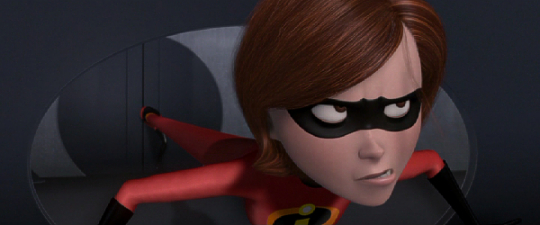
Well, that’s all the good…what about the not-so-good? Having seen the film quite a few times now, I have to say that I now enjoy it a lot more than when I saw it in a theater. Back then, The Incredibles seemed to drag a bit, for me, in the middle of the film, when Bob makes a second visit to Syndrome’s island. At 115 minutes, it’s still one of the longest mainstream animated films out there (I can only think of Fantasia being lengthier, but that isn’t a single-narrative feature), and could probably have been tightened up by ten minutes or so overall. That the story does indeed flow naturally is a big plus point, obviously, but some scenes still feel “bloated” in that style and technique overburden the needs of a scene, and although I haven’t minded that when the movie plays on TV, I found I still actually felt the same way sitting to re-watch it again for this review.
Ironically, one point I did feel needed to be bigger was the film’s climax, on the streets of a city where Syndrome’s Omnidroid robot flips out and causes havoc. As this is about happen, the population runs from their cars and the sidewalks to hide, leaving the city streets feeling a bit barren and empty. More faces and people in peril would have certainly helped here, and as it is the sequence feels light and not as climactic as it should. After such amazing moments on the island, the city battle didn’t work up the kind of energy it needed, and the way the ’droid is finally defeated just felt rushed and too “easy”. A later coda resolves things much more satisfactorily, but the film had definitely stalled for me at that point, and it took me out of their world for a moment. I understand the cost limits and the jobs of the “crowd police”, but I still feel that ending could benefit from some extra activity.
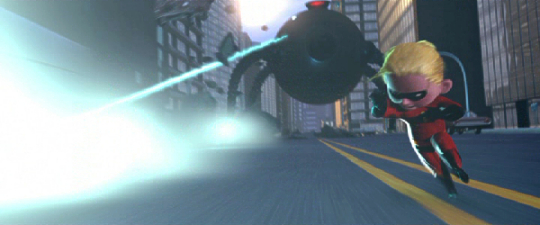
Putting such gripes to one side, time is the real test of a film’s success and it’s clear that Bird and the creative geniuses at Pixar knocked another super-hitter out of the park, their reach also extending to the real comic book geeks as well as animation aficionados and fans of the sci-fi genre. Comparisons made to Spider-Man 2 at the time were inevitable: not only does the film feature the emotional identity crises of its leading characters, but Mr Incredible rescues a train from certain doom in a similar way to Peter Parker’s attempts in that film, and Bird expressed concern during interviews even though his film had featured that sequence long before Spidey 2 got off the ground. Likewise, the Fantastic Four is the team that most comes to mind when looking at who The Incredibles could have been at least related to, and there’s no denying that the family – in their spandex – most resemble the Stan Lee/Marvel Comics prototype of angsty heroes with troubles other than just the “villain of the week”.
Like Shrek, which wanted its cake (to spoof the Disney fairy-tale) and eat it too (to be accepted itself within that fairy-tale tradition), The Incredibles walks that fine line between spoofing the very genre it also wants to be a part of and celebrating it. We’re still yet to see more of the dysfunctional family created here (Bird has said he’s had ideas for a sequel but now seems preoccupied with real-life superheroics of the Mission films that will hopefully lead to his planned epic 1906, about the devastating San Francisco earthquake), but it’s true that this film has already inspired its own sub-genre (Despicable Me, Megamind). It seems the supers are back, and they’re here to stay, but The Incredibles is still the best, pulling off its super-spoofery totally successfully, albeit with expertly timed affectionate swipes and a pure sense of fun (“Bomb Voyage!”) amongst a genuinely exciting and involving adventure romp.
Is This Thing Loaded?
After the spectacularly presented film, you’d be expecting an incre…nope, not going to go there…an exceptional collection of bonus features. For the most part, the original DVD release delivered even if the supplemental section wasn’t quite as fulfilling as other Pixar sets, but here it’s been beefed up a bit by some new to Blu-ray extras, nicely given their own disc so as to give the movie maximum space.
Disc One’s movie platter does hold a few bonuses, as did the DVD, and kicks in with some very stylish menus, forgoing the Mary Blair-esque silhouette designs of the DVD release for a high-tech National Supers Agency computer screen, really helped along by Giacchino’s retro score, which bumps up the excitement factor exponentially. Moving on to the bonus features themselves and I’m not sure if the PG rating for The Incredibles has had any effect, but it does seem to have emboldened the Pixar folks into being a little more carefree with minding their language. I’m no prude, but letting the words “crap” and “ass” creep into a set that may been seen or heard by youngsters didn’t seem a very Disney-or-Pixar-like thing to happen, and as with the DVD I must admit to being surprised that these weren’t simply edited out.
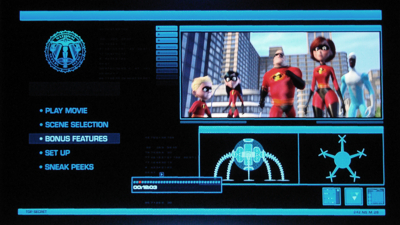
Apart from that caveat, the supplements essentially mirror the DVD, and although we lose the Introduction by Brad Bird (in which he hinted we should use the Home Theater Optimizer before watching the feature, which is still included here), we’re treated to two full-length audio commentaries (the first instances of slightly colorful language): one with writer/director Bird and producer John Walker, the other with an abundance of animators (I counted thirteen introductions in all), including supervising animators Tony Fucile, Steven Hunter and Alan Barillaro. Making up much of the set’s most interesting features, the two commentaries are still among the best recorded for an animated film, the advantage being that since something as complex as The Incredibles takes three or four years to complete, these commentaries were recorded toward the end of production and so they do have a retrospective slant, which always makes things that much more interesting.
The participants speak candidly, and with much enthusiasm, both tracks remaining hugely worthwhile and worth a revisit. Bird and Walker’s track opens up, as expected, the story and characters, plot decisions, alterations and various production choices, while the more technical (and looser-tongued!) animators’ comments reveal the real nitty-gritty nature of production, such as moments that they wish they could have finessed more as well as those that got an overhaul and work much better for it. That Bird and Walker are so animated (no pun intended) themselves is a great bonus, and the mere fact of having so many animators on the other track means that there isn’t any time wasted when someone isn’t talking (and usually saying something interesting). There is literally tons of information, anecdotes, casting choices and more in these tracks, and the exuberance is infectious, though some ID tags on the animators tracks would have been a plus, if only to keep up with who was saying what at which time. The addition of Cine-Explore visual annotations would have been cool and the animators’ comments do sound as if they have been cut from at least a couple of sessions, but they have been expertly edited.
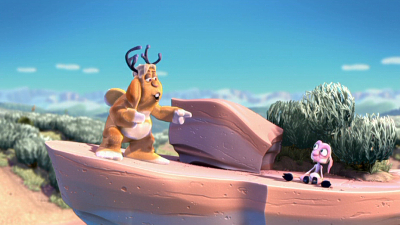
Playing with the main feature theatrically, the Oscar-nominated animated short Boundin’ is also included here, being the directorial debut of long-time storyman Bud Luckey, running 4:40 in HD. Presented in 1.85:1, the short split audiences right down the middle between those that thought it bizarre and silly, and those who warmed to its wonderfully whimsical message – and I firmly place myself with the latter! For those coming to this for the first time, you’re in for a treat, while I should point out that this is like nothing you’ve ever experienced from Pixar before, with a lovely feeling of 1950s Disney shorts but totally groundbreaking in a whole new way, which is what keeps ’em fresh! Accompanying the short is the optional DVD commentary from writer/director/narrative singer Luckey, who warmly reveals his background and influences, as well as the regular appearances from props and characters from previous and following Pixar movies. For those worrying that they can’t find the great little featurette Who Is Bud Luckey?, which profiles the artist (soon to be heard as Eyeore in the new Winnie The Pooh movie) and his work for Pixar as well as behind-the-scenes footage of how Boundin’ was produced, it is in this set, to be found on the second disc.
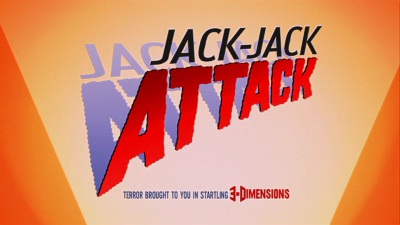
Again written and directed by Brad Bird and featuring Luckey’s vocals, the DVD’s animated short Jack-Jack Attack is undoubtedly amusing on its first viewing, though I still find that it doesn’t stand up to repeated performances, as it isn’t self-contained and so doesn’t work at all as a stand-alone cartoon in the way that other made-for-disc movie spin-off Pixar shorts (Mike’s New Car, Mater And The Ghost Light, etc) do. Jack-Jack Attack, which tells the “background story” of what happened while the family were out saving the day and Kari the babysitter was left alone with their unpredictable baby son, makes various references to the film that, while clever, will be lost on newcomers – one simply has to have seen the main movie to get all the in-jokes. There’s also another language gaff here, which has villain Syndrome explaining why his costume simply has an “S” on it rather than the initials for “babysitter” (which would have been “BS”, geddit?) – don’t worry, the actual word is never mentioned but it’s a close call gag.
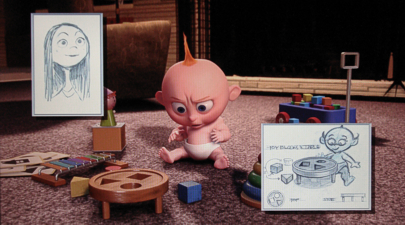
At 4:42 (in HD), this is still a short short, and the more I see it the more it feels like it’s been put together with discarded material left over from the feature production, much like the additional short on Up’s disc release. A new Jack-Jack Attack Exploded visual commentary from Bird and selected crew makes up for the lack of the same on the original DVD’s release or its repeat on the Pixar Short Films collection, and confirms the short actually is an original production created apart from the feature, the constant flow of additional picture-in-picture pop-ups providing a lot of behind the scenes context, which is pretty neat.
Following on from other recent Pixar HD upgrades, The Incredibles’ supplements include various continuations of features begun with the reissues of past titles, and first up is The Incredibles Revisited: Filmmakers’ Roundtable Discussion (22:09, HD) with Bird and Walker joined by many of the crew from the animators’ commentary track to look back on the film’s development and production.

Looser than a commentary but providing more of a perspective, I always enjoy these conversations because the passing of time always brings up new anecdotes and the ability to reflect on some issues that may have been too delicate at the time of a film’s release. As if to express that point, Bird immediately refers to a “former head of Disney who was not a fan of the movie” and could only see it as a live-action film, laying into Bird at a presentation meeting and dictating the rules of “what animation could and couldn’t do” to he director. Impish as a naughty schoolboy, Bird revels in the admission, clearly implying the rift that was then opening up between Disney and Pixar at the time, and there are plenty of other hitherto unknown stories revealed, one of the most amusing being Bird’s stamp of approval for various concepts.
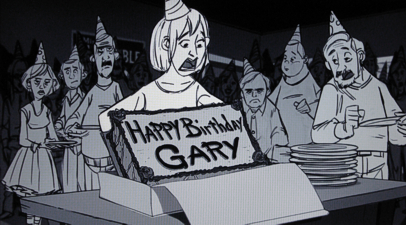
On the second Blu-ray Disc, the new supplements continue with more of the Pixar BD featurettes that have been running through their hi-def upgrades. Paths To Pixar: Story Artists (5:53, HD) outlines the work and backgrounds of several artists, their approach to the process, and advice for those looking to pick up this craft. Studio Stories: Gary’s Birthday (1:25, HD) is another snippet from the roundtable, animated in story sketches as per previous Studio Stories, with Bird explaining in his enthusiastic way the reasoning behind having one giant birthday party for the crew but how they all ended up with Gary’s cake. Ending With A Bang: Making The End Credits (1:35, HD) is a brief but interesting look at the thought process behind the hugely entertaining final credit scroll, while The New Nomanisan Island Top Secret Redevelopment Plan (3:30, HD) sounds like it could be interactive fun, but for some reason my player froze every time I tried to select this extra.
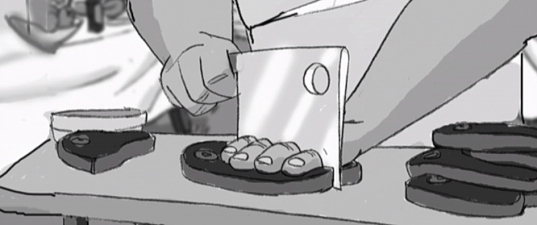
Proving Pixar takes the time and trouble to (usually) make their Blu-ray catalog releases more than just a DVD port-over, we next have the original disc’s selection of Deleted Scenes now in HD. Like the DVD, the approximately 35-minute running time sounds pretty inviting until one realizes that this length also includes a chat between director Bird and story supervisor Mark Andrews, who discuss each scene at length before it plays – I’d have preferred optional commentary here, since what they say is interesting, but pretty boring to watch (Bird, for the first time I’ve noticed, takes a little time to warm up here, for whatever reason). The image’s color, upscaled from SD, is washed out in these talking head sections too, though the scenes themselves, including an extended alternate opening, various scene extensions and different takes, are fascinating in themselves as usual. Image quality on those naturally isn’t a problem – they’re upgraded to HD as promised – but basically being story sketches means there isn’t a great deal of clarity to pick out, elaborate that these mixes of pencil-drawn storyboards and animatic work are, presented in the film’s ratio of 2.35:1 anamorphic widescreen and with completed music cues for effect. Also nice to have is the specially animated The Incredibles Teaser Trailer in HD (2:01).

Moving on to Classic Content (all in Standard Definition) takes us back to the 2005 DVD release for around 70 minutes of behind-the-scenes material, being made up of a 27:24 documentary, The Making Of The Incredibles, and several featurettes which take in various subjects. The documentary isn’t just your run-of-the-mill piece, being an exciting mix of talking head soundbites – all of which predictably applaud Brad – and plenty of video camera footage of the day to day running of Pixar: we see Brad’s first day at the Studio, plus the actual production process, and snippets of creative meetings, which propel his unending energy to the fore. It’s a good half-hour, quickly cut, and manages to play up the famously infectious Pixar spirit and glosses over any production upsets that were rumored at the time.
The individual clips go even more in-depth, concentrating on various production steps, from Story, Character Design, E-Volution (centered on Edna Mode) and Building Humans and Extras, to Set Design, Sound, Music, Lighting and the software Tools involved. The pieces run not as extended versions of clips from the main documentary, but are self-contained, revealing how deep the Pixar people delve in order to convey believability, as well as the lengths they go to in hand animating various elements rather than let the computers go ahead and create them “mechanically”. For all the talk surrounding the big name casting of Nelson, Hunter and Jackson, I still could have done with an additional “voice cast” featurette, but at least one character is outlined later on. A Play All option on the DVD has been dropped here.
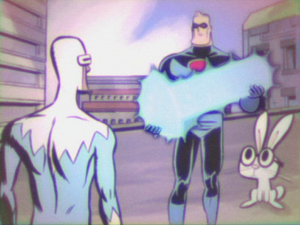
More fun, but losing points in its uneven execution, is another bonus cartoon, Mr Incredible And Pals, coming in at four minutes. Animated using mostly static artwork created in a 1950s cheapo-TV style, the short is a supposedly “lost” episode of a Johnny Quest-type cartoon series featuring our hero and his sidekicks. Expertly rendered with the intended look, along with intended print and transfer anomalies, it’s a great idea and there is a lot of fun to be had here. So what about those lost points? Well, rather than give the characters rudimentary, two-frame animated mouths (one for open, one for closed), they are here provided with real-life human mouths superimposed onto the faces – something that looks out of place given the style (the effect was used in this way on some early shows, but never on this kind of graphic design). The writing and joke performances here make up for those shortcomings, but I couldn’t help feel that the so spot-on gags (the animated boat changing course, Mr Incredible’s animal pal, so accurately recalling the sidekicks of those programs) were let down by the “real mouths” decision, the style working much better in wider shots where there are no mouth movements.
Another option offered is a Bird-written Mr Incredible And Pals cartoon “commentary” by Mr Incredible (Craig T Nelson) and Frozone (Samuel L Jackson) themselves. Though they don’t (intentionally) provide the voices for the short itself, this is a nice way to get them involved, though their in-character chat resorts to that tried, tested and increasingly strained “we’re real characters” shtick, and quickly became a bore for me, with most of it being about Frozone’s bitterness at being portrayed as “tanned” instead of black and attacking the live-action lips (he has a point!), while Mr Incredible pleas that it doesn’t look so bad (although once again there is one use of a surprising word, another “crappy” and others jokingly bleeped out). Also in the same vein are some top secret Nation Supers Agency files, a collection of background information that features a run down of all the superheroes seen in the film, and a look at the crime-fighting teams the members once came together as. Unfortunately this was the second bonus on the disc to crash my player, but from the DVD I recall that the statistics, lengthy audio sound bites of the “where are they now” variety and the names and “facts” are very funny and inventive.
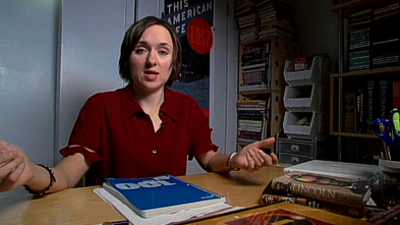
Moved from accompanying Boundin’ on the first disc is the featurette Who Is Bud Luckey? (3:55), and Vowellet: An Essay By Sarah Vowell takes a curious look at one of the film’s lesser-known voice talents. Running just over nine minutes, it took me a while to get used to Vowell’s manner, which gets a little off-hand in the mid-section, but when she warms up the piece is truly funny (“different”, in a good way) and it’s easy to enjoy her take on both her life and the process of being involved with a big animated movie (though be warned that the “crap” word springs up again here), and we see the animation test that convinced her to become involved. A quirky, interesting person, Vowell turns out to be quite the American history buff, and the mini-doc comes complete with a nice push for Pixar chief Steve Jobs’ other business concern, the Apple iMac (still looking cool even now, but watch how Vowell flubs here, after mentioning it, not that I’m suggesting that she was asked to play that aspect up or anything)!

An Art Gallery (HD) features several sections (covering Character Design, Collages and Color Scripts, to Lighting, Set Design and Storyboards), but again it’s not an amazingly in-depth selection of images. Even though these are now in hi-def, they group pairs of images together instead of being able to see each one closer, and still missing are the much stylized promotional posters and numerous one-sheets and banners that invited audiences to see the film. Originally strewn across the DVD set’s two discs, that selection of Easter Eggs are now grouped all together here for easier access and, even better, offered in a Play All configuration running over 15 minutes. These are pretty inventive: one is a tribute to the animators from Brad Bird, which features all the shots of doors and buttons being open, closed, pressed and pushed, which just makes one astonished at the number of these things in the film, and a testament to what is obviously an in-joke between the filmmakers.
Also included here is the series of Incredi-Blunders (1:40), but they aren’t the kind of bloopers that Pixar became famous for; instead we see a collection of test renders, where pieces of jumbled code have resulted in shots not coming out as intended. In an attempt to give the clips some wider-than-just-the-technical-geek appeal, a swinging music and laugh track has been added, which I actually found a little too much, and the whole thing whizzes by rather than the usual way of presenting these, which is on a repeating cycle. Sound effects jazz up the shots, but it’s all too easy to miss the more subtle stuff on a first viewing. Another Egg is a fairly amusing cut-down version of the entire film as acted out by…sock puppets, and there’s also a look at the lengths the animators go to in providing authenticity, another deleted scene, a scooter accident clip (is that a SharkTale poster on the Pixar wall?), and a nice tribute to Frank Thomas and Ollie Johnston (“no school like the old school”!), among others – the only issue being that the 16:9 footage has not been anamorphically un-squeezed.
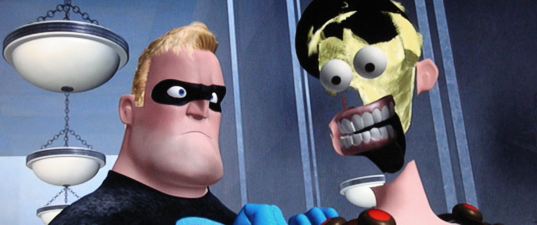
Bringing things to a close is a Publicity section, which includes more “they’re actual people” character interviews between a few real life TV hosts and Mr and Mrs Incredible, Frozone and Edna Mode (6:30), plus two additional theatrical trailers, six ABC Stunts spots and three commercials, adding another seven minutes of material. Sadly, the First In Line promotional TV spots that spoofed the early line up some fans commit to when a big new film opens, are still inexplicably missing, and those additional publicity poster and banner images would have been a real boon too – the film was well marketed with such stylish artwork which is all missing here.
On the DVD, if you already own The Incredibles on the format, then you already have a better disc than this, which includes the main feature and the Boundin’ and Jack-Jack Attack shorts only, without any commentaries or any other extras. I also found, even though they theoretically have more space to stretch out on, image and sound quality on the disc to be inferior to the earlier DVD, with a softer picture and audio that leans much more into the lower bass frequencies and sounds clumpier as a result. The enclosed Digital Copy disc features the main feature only, and across all the discs, various Sneak Peeks include Cars 2, The Lion King and a Disney Parks spot.
Case Study:
To all intents and purposed, The Incredibles‘ switch to Blu-ray isn’t so far off their DVD treatment, the original foil slipcover replaced with an embossed one that pretty much follows the same dark red color scheme. Following recent Pixar upgrades, the front is divided into a characters side against the title treatment side, though I’m not too sure about how the characters are placed: Mr Incredible is almost lost in the top left, and there’s an absurd amount of focus pulled towards Elastigirl’s left hand, which swamps a huge section of the cover and actually looks quite freaky scary, something that isn’t helped by the family all looking pretty mean and reminding me of burglars! Other than that, it’s all pretty standard Disney DVD stuff, with the same artwork reproduced on the cover and promos for 3D and an offer of a movie ticket for Cars 2 inside.
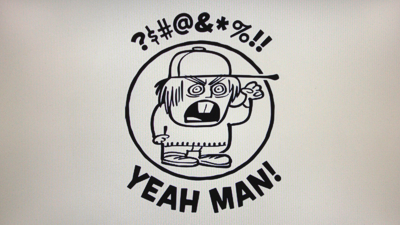
Ink And Paint:
Presented as on the DVD in its correct 2.39:1 widecsreen framing and often shooting close to full bitrate as possible, I have to say that I didn’t think The Incredibles looked as super-sharp as I was expecting in its Blu-ray debut. However, it’s not an unintentional thing, and perhaps this soft edge is reflective of Bird’s approach to the cinematography, which like Superman: The Movie recalls a more romantic time for superheroes to shine. Of course, we’ve also become accustomed to overly sharp recent animated features and perhaps Pixar’s render power wasn’t as well honed in 2004, the rendering not coming over quite as detailed as I expected, the usual smoothness of the Studio’s visual trademark showing up ever so more clearly than before. But it’s still a stellar transfer, and there’s never any hint of compression or color banding, with fine skin tones and blacks so solid that they never lose any shadow detail.
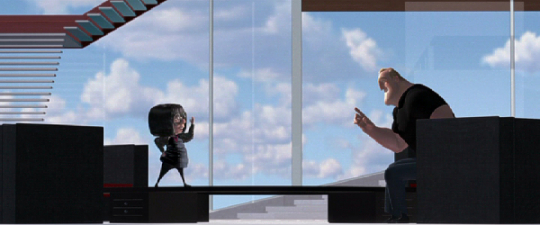
Scratch Tracks:
If there’s any (very minor) disappointment with the visual image, the DTS-HD 5.1 Master Audio ES track more than makes up for it, the main catalyst being Giacchino’s bombastic music again, quite naturally, abetted by a terrific sound design that has great fun with the superheroics and gadgets. As with the DVD, the 100 Mile Dash chapter – the highpoint of the film – is still a system demo worthy sequence. Descriptive Audio (Dolby 2.0), French, Spanish, Mexican and Argentinean Dolby Digital 5.1 EX tracks are also bundled in, sounding as top notch as one would expect, and in a particularly excellent touch, subtitles are available in English, French and Spanish both for the movie and selected bonus features, including commentaries! Not much more to say than that, really, but it’s nice to see the thought-out detail from the DVD hasn’t been lost here.
Final Cut:
Although the previous year’s Finding Nemo broke away from the Randy Newman-scored Pixar standard, The Incredibles made another jump away from the Studio’s comfortableness by not relying on the buddy-buddy format that had driven and sustained their reputation, and it was a daring choice to not only hire in an “outsider”, Brad Bird, as a director but also to allow him to push the boat out as far as he did in what could be considered appropriate for an apparent “children’s film”. As the PG rating testifies, The Incredibles aims a little higher than that, and it has become that rare thing: a true family feature that invites questions and provides food for thought while being thoroughly engaging.
As I say above, I still find it a little saggy in the middle, and the watered-down climax isn’t the best thing in the show, but to all intents and purposes, it remains fantastic entertainment that finally bridges the gap between casual sci-fi fan and geek: spoofing the genre while playing by the rules and working on both counts. Its debut on Blu-ray still misses out a couple of expected extras alongside what seems to be an intentionally warm glow image, but the reference-quality sound, two great audio commentaries and a handful of new supplements make up the solid status of The Incredibles on BD. There should be more than enough in here to please fans, even those with the previous disc, without compromising the quality of the feature presentation, and that’s what really counts – it looks and sounds…oh, okay then…incredible!
 | ||
 |


